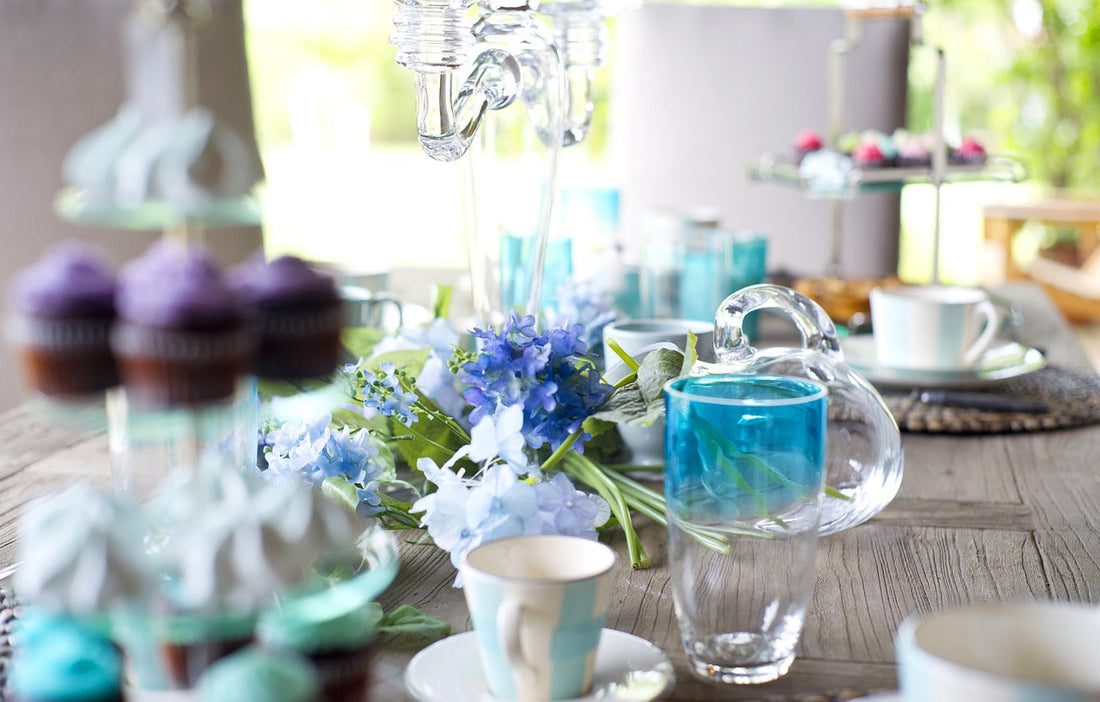
How to Curate the Perfect Tea Selection for Your Gatherings
Michele LillieWhat a treasure it is to gather together with family and friends. Whether it’s a casual get-together or a formal affair, whether you are celebrating the beauty and warmth of summer or cozying up for a holiday party, selecting suitable teas for guests can turn a simple gathering into a memorable event. Let’s explore how to navigate the process of choosing those teas.
Consider Your Menu
Do you wish to serve tea during your dinner, or will you just offer it with dessert or as an after-dinner beverage? Spend some time picking teas that will complement and not detract from the food.
Understanding Your Guests
Begin by considering the preferences of your guests. Are they seasoned tea drinkers or new to the nuances of loose leaf? Do they favor bold flavors or subtle notes? Gathering this information can be as simple as a conversation or providing a selection that caters to all palates.
The Tea Spectrum
There is a range of teas for your guests that span the full spectrum of flavors. Choosing a few teas from these different types will help to please the varying palates of your guests. An excellent place to start is to offer a black tea, a green tea and a caffeine-free selection.
-
Black Tea: Robust and energizing, black teas are perfect for guests who appreciate a hearty brew. They pair wonderfully with meat dishes, cheesy pasta dishes and chocolate desserts. Although a safe choice would be an English Breakfast tea, a lighter black tea, such as a single-origin tea from China or Ceylon, might appeal to more guests.
-
Green Tea: For a lighter touch, green teas offer grassy and fresh notes that can cleanse the palate and refresh the senses. They are a delightful companion to salads, seafood and soft cheeses. Unless your guests are devoted green tea drinkers, opt for a Chinese green tea as they tend to have less grassiness. Examples would be Dragonwell (Long Jing) or Chun Mee (Zhen Mei.)
-
Oolong Tea: With a complexity that intrigues the connoisseur, oolongs are classified as either light or dark. Lighter oolongs pair nicely with fruits, seafood, Asian cuisine and white meats. Darker oolongs do better alongside roasted veggies and darker meats. Examples of the former are Jade and Pouchong, whereas Formosa, Red Robe, and Oriental Beauty belong to the dark oolong category.
-
White Tea: Subtle and delicate, white teas are perfect for the refined palate. They are delightful on their own and should be paired with only the mildest flavors, such as light fish, basic salads, and simple pastries and desserts.
- Herbal & Fruit Infusions: Ideal for evening gatherings, caffeine-free herbal blends provide soothing flavors that can relax and calm. They are a considerate option for those avoiding caffeine. For pairings, take your cue from the flavors in the infusions. Fruity and minty brews will be great with light desserts and pastries. Infusions with spices and chocolate are a perfect complement to fall flavors.

Seasonal Selections
Embrace the season with your tea choices. A spiced chai might warm a winter’s evening, while a chilled hibiscus blend can cool down a summer soiree. Seasonal selections not only taste great but also add to the thematic charm of your gathering.

Timing considerations
If you want to serve the tea with your dinner, choose teas that do not have flavorings added to them, such as fruits, flowers, or spices. Let the true and natural flavor of the tea enhance the food. An exception would be dessert. This would be the time to offer a tantalizing flavored tea. Brew a jasmine green tea to pair with a fruit compote. A fruity tea could be wonderful with a vanilla panna cotta. Serve teas with warmer flavors such as chai, chocolate, or nuts with a coffee cake, spice cake, a fall fruit crumble, or a platter of chocolate truffles. Finally, offering a selection of teas on their own after all the food could be the perfect ending to an exquisite evening.
Presentation
Presentation is key. You will want to use cups that complement your table setting if serving tea with dinner. If serving with dessert or afterward, consider using clear tea cups that showcase the tea’s beauty.

Practicalities
Plan the evening so that the tea is properly brewed and at a drinkable temperature when you serve it. For brewing advice, see this prior Brewing Guide Post. For serving with dinner, brew the tea in a pretty pot or two (depending on how many guests you have) and keep it warm on tea warmers. Using a tea infuser or pot-sized fill-your-own disposable tea bags is easy work.
The same method may be used if serving tea after dinner. You could also make it more interactive by having a tea station where guests can choose and brew their own tea. Once again, you could use tea infusers if you have a sufficient number for all your tea-drinking guests. You would also need to provide measuring spoons and somewhere to place the infusers after brewing.
A simpler solution would be to prefill cup-sized tea bags with your tea offerings. Guests can then easily brew the tea of their choice. Don’t forget to provide a container to dispose of the used tea bags.
Finally, providing different sweeteners, milk and spoons is a thoughtful gesture.
Final Touches
As you steep and pour, share stories about the teas – their origins, the farmers who cultivated them, and the traditions they represent. This educates and enriches the experience, making each sip a journey.
In selecting teas for your guests, you are not just offering a beverage; you are creating an experience that warms the body, invigorates the mind, and connects spirits. Enjoy the process, and let the shared cups of tea draw your gathering into a closer, more harmonious circle.